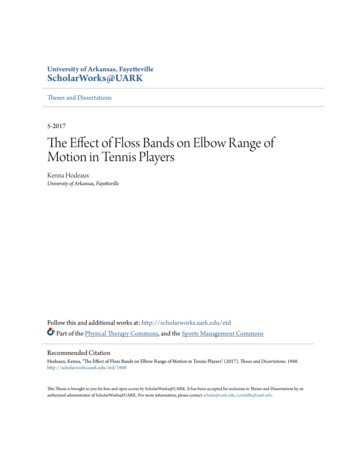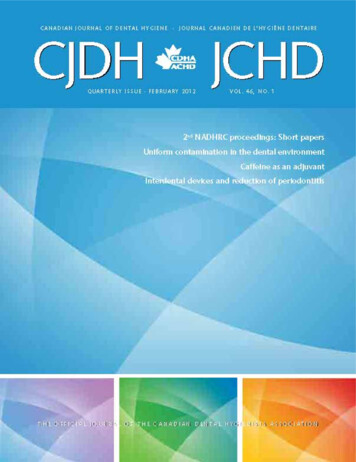
Transcription
University of Arkansas, FayettevilleScholarWorks@UARKTheses and Dissertations5-2017The Effect of Floss Bands on Elbow Range ofMotion in Tennis PlayersKenna HodeauxUniversity of Arkansas, FayettevilleFollow this and additional works at: http://scholarworks.uark.edu/etdPart of the Physical Therapy Commons, and the Sports Management CommonsRecommended CitationHodeaux, Kenna, "The Effect of Floss Bands on Elbow Range of Motion in Tennis Players" (2017). Theses and Dissertations. 1948.http://scholarworks.uark.edu/etd/1948This Thesis is brought to you for free and open access by ScholarWorks@UARK. It has been accepted for inclusion in Theses and Dissertations by anauthorized administrator of ScholarWorks@UARK. For more information, please contact scholar@uark.edu, ccmiddle@uark.edu.
The Effect of Floss Bands on Elbow Range of Motion in Tennis PlayersA thesis submitted in partial fulfillmentof the requirements for the degree ofMaster of Education in Recreation and Sport ManagementbyKenna HodeauxTexas Christian UniversityBachelor of Science in Athletic Training, 2015May 2017University of ArkansasThis thesis is approved for recommendation to the Graduate Council.Dr. Steve DittmoreThesis DirectorDr. Brendon McDermottCommittee Member!Dr. Terry EddyCommittee Member
AbstractFloss bands have been used to improve ROM, restore joint mechanics, and break downadhesive tissue from previously injured musculature, however, there is limited research availableand the few research studies have mixed results on the usefulness of floss bands. The purpose ofthis study was to investigate the effectiveness of floss bands in increasing elbow range of motion(ROM) in tennis players. Twelve elite tennis players (6 female and 6 male) participated in thisrandomized crossover design study. Subjects attended two separate sessions. Passive ROMmeasures were taken with a standard goniometer for elbow flexion and extension and forearmpronation and supination. For each session baseline ROM was initially taken. Subjects went intoa separate room to have the intervention applied (floss band or no band) to ensure the author wasblind to eliminate bias. After the intervention was applied ROM was re-measured. On theirsecond visit, participants received the intervention that was not previously applied. A pairedsample t-test revealed no significant difference (p 0.05) between floss band and no band for allmeasures. This study is the first to investigate the use of floss bands to improve elbow ROM inelite level tennis players. The results show that floss bands are do not significantly improveelbow ROM compared to other treatment methods.!
AcknowledgmentsSpecial thanks to Christopher Blaszka for all of his help with this thesis. It would havebeen impossible to complete this study without his help.Also, a special thanks to the thesis committee for their advice and guidance.!
Table of ContentsI. Introduction .1II. Background .3III. Methods .6A.! Design .6B.! Participants.6C.! Measures and Instrumentation .6D.! Procedures .7E.! Data Analysis .10IV. Results.10V. Discussion.14VI. Conclusion .16VII. References .17VIII. Appendices .19A.! Consent Form .19B.! Research Compliance Protocol Letter .22!
!!! 1I.! IntroductionThe use of Voodoo Floss Bands, or simply floss bands, in sport has become increasinglypopular because it incorporates movement though a particular range of motion (ROM) inconjunction with therapy. Originating in crossfit gyms and made popular by the book BecomingA Supple Leopard (Starrett & Cordoza, 2013), floss bands are used to improve ROM, restorejoint mechanics, and break down adhesive tissue from previously injured musculature. The twoinch wide latex rubber band is wrapped around a joint which provides compression while thepatient performs movement through the full ROM for one to three minutes. However, there arefew research articles to support the use of and mechanisms behind the effectiveness of flossbands.Current literature of the effects of floss bands is limited to a few studies (Bohlen et al., 2014;Driller & Overmayer, 2017; Plocker, Wahlquist, & Dittrich, 2015). Bohlen et al. (2014)investigated the effects of 14 days of band flossing combined with joint mobilization andresistive exercise on calf blood flow and plantar/dorsiflexion strength in five participants. Flossbands were applied to the experimental leg over the knee while the participants performedunloaded squats, heel raises, active dorsiflexion, and passive ankle mobilization once a day.Blood flow was measured with venous occlusion plethysmography and strength was measuredusing an isokinetic dynamometer. The authors found that with the use of floss bands,dorsiflexion peak torque was increased by 22% and vascular function and strength were notaffected in the experimental leg (Bohlen et al., 2014). Driller & Overmayer (2017) evaluated theeffect of floss bands on ankle ROM and jump performance in 52 recreational athletes.Participants performed a weight bearing lunge test, plantar/dorsiflexion ROM, and a single legvertical jump test before and after the band was applied. The floss band was applied to one ankle,!
!!! 2while the other ankle acted as control, and the subjects performed 20 repetitions of plantar anddorsiflexion simultaneously. The authors found significant improvement in all ROM measures aswell as single-leg jump performance after the use of a floss band. However, these results may beskewed due to the low confidence interval (CI 90%). Contrary to these findings, Plocker et al.(2015) examined the effectiveness of tissue flossing on increasing upper extremity power andROM in 17 male athletes. Subjects attended two sessions, one with the floss band and onewithout the floss band. During the treatment session, researchers wrapped both shoulders withthe floss bands using guidelines from the manufacture and led the subjects through shoulderprehabilitation exercises. Once the band was removed, ROM was measured using a goniometerand upper extremity power was measured using a 3D accelerometer during a bench press.Although Plocker et al. (2015) saw a mean increase in internal and external shoulder ROM, therewas not a significant increase in ROM or upper extremity power. These results may beinfluenced by the fact that the suggested wrapping technique did not efficiently cover all themuscle groups in the shoulder.There is a large consumer appeal for using floss bands, however, there is limited evidence ofits true effects. Although patients have seen notable improvements after treatment usingprotocols and standards from various blogs and company websites, no medical journals orpractices have any set protocols on tension of the band, wrapping techniques, or movementprograms to dictate the proper use of floss bands. The lack of protocols can lead to inaccurateresults and varied effects. The scarcity of evidence on floss bands warrants further investigation.Users claim one of the main benefits from using floss bands is an increase in ROM. However, astudy investigating the effectiveness of floss bands on elbow ROM has yet to be done. Therefore,!
!!! 3the purpose of this study is to investigate the effectiveness of floss bands in increasing elbowROM in tennis players.II.! BackgroundAs overhead athletes, tennis players are highly susceptible to elbow injuries due to the largeforces at the elbow joint (Eygendaal, Rahussen, & Diercks, 2007). Tennis players use acombination of valgus forces and rapid extension which result in tensile forces along the medialaspect, compression on the lateral portion, and shear forces in the posterior compartment of theelbow (Eygendaal et al., 2007). Biomechanical analysis reveals that the elbow moves from 116oto 20o flexion within 0.21 seconds during a tennis serve (Eygendall et al., 2007). It has beenshown that overhead athletes have a significant decreased ROM in elbow extension and flexion(Wright et al., 2006). Normal ROM for elbow flexion and extension is 0 to 145-155 degrees andfor forearm pronation and supination it is 0 to 90 degrees (Starkey, Brown, & Ryan, 2010).When there is a lack of full ROM, athletes can experience a decrease in power and an increasedrisk of injury (Weerapong, Hume, & Kolt, 2004).Starrett and Cordoza (2013) proposed the mechanisms behind floss bands include fascialshearing and occlusion of blood to the muscle. Fascia is a type of connective tissue thatsurrounds the muscles, tendons, nerves, bones, and organs (Prentice, 2011). The compressionand movement of floss bands on the muscle alters the relation of the fascia with theneuromusculoskeletal system which allows for the fascia to stretch and move freely (Starrett &Cordoza, 2013). Blood flow restriction (BFR), joint mobilizations, and stretching are all types oftherapy that are similar in effects to what floss bands claim to accomplish.BFR training utilizes a similar application as floss bands but its purpose is to improve musclestrength. BFR uses a band or blood pressure cuff which is wrapped around the muscle belly and!
!!! 4inflated to pressures between 50 to 250 mm Hg (Pope, Willardson, & Schoenfeld, 2013). Greatertraining adaptations (such as strength and hypertrophy) have been shown when using BFR whileperforming low intensity exercises (Loenneke, Wilson, Marin, Zourdos, & Bemben, 2011).Current theories are being studied to determine the exact mechanisms behind BFR. It ishypothesized that by occluding blood flow to the muscle, there is an increase in fiber typerecruitment, metabolic accumulation, stimulation of muscle protein synthesis, and cell swellingwhich results in significant increases in muscle hypertrophy, strength, and endurance (Loennekeet al., 2011). Increases in growth hormone and lactate concentrations have been observed afterthe use of BFR (Reeves et al., 2006; Takarada et al., 2000). Elevated growth hormoneconcentrations indicate the stimulation of muscle growth, development, and strength (Reeves etal., 2006). Concentrations of lactate was twice as large after exercise with BFR suggesting thatthe sympathetic nervous system is stimulated from local hypoxia (Takarada et al., 2000). Flossbands use similar principles and wrapping techniques, however the treatment is much shorter andapplied over the joint.Joint mobilizations are a common manual therapy used to increase range of motion anddecrease pain. Heiser, O’Brien, and Schwartz (2013) conducted a systematic review of currentevidence for the use of joint mobilizations in treatment of conditions at the elbow, wrist, andhand. For patients with lateral epicondylalgia, more commonly known as tennis elbow, there ismoderate evidence that: mobilization with movement will have a positive effect on pain andstrength in the short term, elbow mobilizations have a positive effect on ROM in the short term,mobilization is as good or better than a corticosteroid injection in the long term, and jointmobilizations have a positive effect on function in the short and long term (Heiser et al., 2013).!
!!!! 5Floss bands claim to have similar increases in ROM as joint mobilizations, however, there is alack of evidence to support these claims.Studies have shown there are acute changes in ROM after stretching (Beltão, Ritti-Dias,Pitangui, De Araújo, 2014). There are four main stretching techniques that are used to improverange of motion: ballistic, dynamic, static, and proprioceptive neuromuscular facilitation (PNF)(Weerapong, Hume, & Kolt, 2004). Ballistic stretching is an older stretching technique whichinvolves repetitive bouncing motions to produce quick stretches of the antagonist muscles.Dynamic stretching has become the preferred method of stretching prior to activity because itinvolves controlled stretches that are more functional in movement. The static stretchingtechnique is widely used because it involves passively stretching an antagonist muscle by placingit in the maximal position of stretch and holding it there. However, it has been shown that usingstatic stretching before exercise can lead to decreases in performance and increased risk in injury(Kay & Blazevich, 2011). The final technique, PNF, involves a combination of alteringcontractions and stretches which can produce dramatic increases in ROM in one treatmentsession. According to Weerapong et al. (2004), all of the stretching techniques are all effective inincreasing static flexibility which is measured by joint ROM. McMillian, Moore, Hatler, andTaylor (2006) compared dynamic versus static stretching warm up on power and agilityperformance in 30 military cadets. For three days subjects performed a 10-minute dynamic warmup, static warm up, or no warm up and then completed three tests for power or agility. Theauthors found that subjects who performed a dynamic warm up had significantly betterperformance scores in all three tests (McMillian, 2006). Perrier, Pavol, and Hoffman (2011)found an increase in countermovement jump height was greater after dynamic stretching in 21male athletes compared to static or no stretching. Maintaining flexibility is important because!
!!!! 6during sport it is difficult to control for rapid stretch rates. When forces are applied rapidly it willcause the soft tissues (tendons, ligaments, muscles, joint capsules, skin, and fascia) to react in astiff, brittle fashion resulting in elastic deformation resulting in injury (Weerapong et al, 2004).III.! MethodsA.! DesignA randomized crossover design was used for this study. Participants attended two separatesessions for the independent variable: stretching (control) and floss band (intervention). Thedependent variable, ROM for elbow flexion and extension and forearm pronation and supination,was measured using a goniometer. Each participant had at least 24 hours of rest from tennis andthe previous session to ensure there is no carryover. According to Reinold et al. (2008) inbaseball pitchers ROM changes were present at least 24 hours after throwing, which is why 24hours was set has the minimum time in between sessions.B.! ParticipantsTwelve college-age competitive tennis players (6 men/6 women, mean age SD; 20.5 1.24years) were recruited for this study. Participants were excluded from the study if they presentedwith surgery to the elbow in the past year, known allergy or sensitivity to latex, or compromisedcirculation in the arms. All participants were instructed about the data-collection procedures andwere given a written informed consent form.C.! Measures and InstrumentationMeasures of elbow flexion and extension and forearm pronation and supination ROM wereperformed using a handheld manual goniometer (Baseline Goniometer, USA). ROM measureswere taken before and post intervention for each trial (floss band, Rogue Fitness MobilityWOD Voodoo Floss Band 7’, USA, and control). Elbow flexion and extension were!
!!!! 7performed with the participant in a supine position, the shoulder in a neutral position, theforearm supinated, and a bolster under the distal humerus (Starkey, Brown, & Ryan, 2010). Thefulcrum was centered over the lateral epicondyle, with the stationary arm aligned up through theacromion process along the humerus and the movement arm aligned with the styloid process ofthe radius. Elbow flexion and extension measures were taken with reference to the neutral (0 )position with extension being the neutral position. The inter-rater and intra-rater reliability ofelbow flexion and extension had shown good reproducibility (intraclass correlation coefficient(ICC) 0.48-0.93) using a goniometer (Chunang et al., 2007). Forearm pronation and supinationwere performed in a seated position with the shoulder in a neutral position, elbow flexed to 90 rested on a table, and a pencil in a tight fist (Starkey, Brown, & Ryan, 2010). The fulcrum of thegoniometer was aligned with the head of the third metacarpal with the stationary armperpendicular to the floor and the movement arm parallel to the pencil. Forearm pronation andsupination started in neural position (forearm horizontal to the floor, palmar aspect of the handfacing medially with the thumb directed upward) which read 0 on the goniometer. The handheld pencil method of measuring forearm pronation and supination has an acceptable intra- andinter-tester (ICC 0.86-0.98) reliability using a manual goniometer (Karagiannopoulos, Sitler, &Michlovitz, 2003).D.! ProceduresSubjects were randomly assigned into treatment or control trial (Random TeamGenerator, https://www.randomlists.com) to determine which intervention was administeredfirst. The goniometric evaluator was blind to which intervention subjects received to control forbias. In order to maintain reliability and provide consistency, the author performed thegoniometric measures and one research assistant performed the interventions. For each trial,!
!!!! 8participants began by placing an elasticated tubular bandage (Tubigrip size D, UK), cut tocover from the mid forearm to mid bicep, on the dominate arm. This was done to cover themarks left on the skin from the floss bands to ensure the author was truly blind as to whichintervention was applied. ROM measures were taken three times for each measure and theaverage of those three measures was used in order to increase reliability of the measures. Afterbaseline ROM was taken, subjects were taken to another room to have an intervention applied.The intervention protocol (band tension, movements, and treatment time) was created inreference to the company’s recommendations (Rogue Fitness MobilityWOD). The treatment trailhad the floss band applied distal to proximal with approximately 50% tension on the band andeach subsequent wrap overlapping the previous by 50% covering the entire joint and securingthe remainder of the band under the final wrap. Once the floss band was applied, the researchassistant guided the subject through a series of six ROM exercises with three repetitions for eachexercise with the band (see Figure 1 for descriptions and pictures). In preliminary trials theexercise protocol took approximately 2 minutes to complete all of the exercises, however, theparticipants were not timed during the intervention. The band was taken off immediately if thepatient experienced claustrophobia, numbness, or discoloration of the hand. The control trial wastaken through the same motions as the treatment trail without the band on. After the interventionwas applied, the participants put the elasticated tubular bandage back on before having the ROMmeasured again under the same standards as stated above.!
!!!Figure 1MotionElbow flexion to elbowextension with wrist andhand in anatomical neutral! 9Repetitions Picture3 timesElbow flexion to elbowextension with forearmpronation3 timesElbow flexion with wristand hand external rotationto elbow extension withwrist and hand internalrotation3 timesElbow flexion with wristand hand internal rotationto elbow extension withwrist and hand externalrotation3 timesElbow in extensionforearm supinatedflexion/extension of thewrist3 timesElbow in extensionforearm pronatedflexion/extension of thewrist3 timesFigure 1 – Descriptions and pictures of the movements the subject was guided through during theintervention by the researcher.!
!!!! 10E.! Data AnalysisStatistical analyses were performed using the Statistical Package for Social Science (V. 23.0,SPSS Inc., Chicago, IL). A paired samples t-test was performed to compare the differencesbetween no band and band for each measure. Statistical significance was set at p 0.05 for allanalysis.IV.! ResultsThere were no significant differences between floss band and no band for any measures. Theresults can be found in Table 1 through 3. Although the difference post intervention favored thefloss band, it was not at a significant level. Based off Figures 2 through 5 it is easy to see thatthere is not a significant difference between post band application and post control.!
Table 1 - No significant differences were found. Flex, flexion; Ext, extension; Pron, pronation; Sup, supination, Diff, difference. Firstnumber listed is with no band. Second number (2) is with floss band.11!
!!!!Table 2 – Data are mean degrees for all subjects. Flex, flexion; Ext,extension; Pron, pronation; Sup, supination, Diff, difference. Firstnumber listed is with no band. Second number (2) is with floss band.12!
!!!Difference Flexion (Figure 2)2015!Series1Series2Difference Extension (Figure 3)2Series3Series40Series4-5Presence of BandBandDifference Pronation (Figure eries11No Band Presence of Band BandSeries12No BandPresence of 0Series5Series6Series11Difference Supination (Figure 5)Series410-5-12Series315Series7Series8Series11No ries11No BandPresence of BandBandSeries12Figure 2-5 – Post measure comparison for No Band and Band for each subject. No significant changes were found.13!
14!V.! DiscussionThis is the first study to investigate the use of floss bands on elbow flexion and extensionand forearm pronation and supination in elite athletes. The findings indicate there is nosignificant benefit from using floss bands to improve ROM (p 0.05, Table 1). This suggests thatfloss bands are not effective in increasing ROM in the elbow. Although, some participants(Series 1 and Series 4 in Figures 2-5) saw a mean increase in ROM after the use of the flossbands, these subjects presented initially with a restriction in motion.Although this is the first study to evaluate the use of floss bands on the elbow, the resultssupport the only other study to investigate the use of floss band on the upper extremity (Plockeret al., 2015). Plocker el al. (2015) did not find any significant improvements in shoulder ROM orupper-extremity power after the use of the floss bands. However, these results refute the onlyother previous study to evaluate the use of floss bands in the acute setting. Driller andOvermayer (2017) found significant improvements in all ankle ROM measures and in single-legjump performance after the application of the floss band in 52 recreational athletes. However, allresults were association with a small effect size ( 0.2) (Driller & Overmayer, 2017). The onlyother study to investigate the use of floss bands was in a chronic (14-day) setting which found anincrease in dorsiflexion peak torque (Bohlen et al., 2014).There is an enormous amount of force across the elbow during tennis strokes which resultsin valgus and extension overload over the joint (Eygendaal et al., 2007). The force productiongenerates power to hit the tennis ball. These forces place the ligamentous, osseous,musculotendinous, and neural structures of the elbow at an increased risk for injury (Eygendaalet al., 2007). It has been shown that elite tennis players have significantly reduced ROM in thedominant arm compared to the non-dominant (Ellenbecker et al., 2002). Due to this lack of!
!!!! 15ROM, tennis players would be more likely to see ROM benefits from the floss bands comparedto the average population.The exact physiological mechanism behind floss bands is yet to be determined. However,floss bands provide partial vascular occlusion which may produce numerous physiologicalresponses after the band is removed. It has been shown that BFR results in increased muscularstrength, hypertrophy, localized endurance, and cardiorespiratory endurance via neuromuscularand endocrine adaptations (Loenneke et al., 2011; Pope et al., 2013). Takarada et al. (2000)found an increase in growth hormone, norepinephrine, and lactae concentrations after exercisewith occlusion. These hormone levels indicate that when blood flow is occluded trainingresponses are present with lower intensity exercises (Pope et al., 2013). The increase in localizedblood flow post band removal may play a role for the use of floss bands, however this has notbeen studied.A limitation of this study was the small sample size. Results could have been influenced bya larger group. Another limitation was that the band application was done by hand, so the tensioncould have varied between participants. However, this potential limitation was minimized byusing the same individual apply the band for all participants. A further limitation could beattributed to the that the test subjects subconsciously tried harder to improve their ROM after theintervention was applied.Further research should investigate the physiological effects of floss bands. Although thisstudy found no significant benefits in ROM after using the floss band, the localized blood flowand hormonal response may contribute to other benefits of floss bands. Further research is alsowarranted to investigate the psychological effects of using floss bands. Although it was notevaluated in this study, many subjects reported “feeling better” and a perceived improvement in!
!!!! 16ROM after the use of the floss bands. Future research should investigate the effects of placebowith the use of floss bands.VI.! ConclusionThis study is the first to investigate the use of floss bands to improve elbow ROM in elitelevel tennis players. The results suggest that floss bands are do not significantly improve elbowROM compared to other treatment methods. Floss bands may have other applications in sport,however for increasing ROM, this study indicated that floss bands are not significantly useful.!
!!!! 17VII.! ReferencesBeltão, N., Ritti-Dias, R., Pitangui, A., & De Araújo, R. (2014). Correlation between Acute andShort-Term Changes in Flexibility Using Two Stretching Techniques. InternationalJournal of Sports Medicine, 35, 1151-1154.Bohlen, J., Arsenault, M., Deane, B., Miller, P., Guadagno, M., & Dobrosielski, D. (2007).Effects of applying floss bands on regional blood flow. International Journal of ExerciseScience: Conference Proceedings, 9(2).Chunang, Y., Chang, Y., Hshiao, Y., Wu, W., Huang, Y., Chuan, T., & Chang, H. (2007). Testretest reliability and inter-rater reliability of elbow range of motion measurement. Journalof Biomechanics, 40(2), S630.Donatelli, R., & Wooden, M. J. (2001). Dysfunction, evaluation, and treatment of the elbow. (4ed.). New York: Churchill Livingstone.Driller, M. W., & Overmayer, R. G. (2017). The effects of tissure flossing on ankle range ofmotion and jump performance. Physical Therapy in Sports.Ellenbecker, T., Roetert, E., Bailie, D., Davies, G., & Brown, S. (2002). Glenohumeral joint totalrotation range of motion in elite tennis players and baseball pitchers. Medicine & Sciencein Sports & Exercise, 34(12), 2052-2056.Eygendaal, D., Rahussen, F. T., & Diercks, R. L. (2007, July 17). Biomechanics of the elbowjoint in tennis players and relation to pathology. British Journal of Sports Medicine,41(11), 820-823.Heiser, R., O'Brien, V. H., & Schwartz, D. A. (2013). The use of joint mobilization to improveclinical outcomes in hand therapy: A systematic review of the literature. Journal of HandTherapy, 26(4), 297-311.Karagiannopoulos, C., Sitler, M., & Michlovitz, S. (2003). Reliability of 2 functionalgoniometric methods for measuring forearm pronation and supination active range ofmotion. Journal of Orthopaedic & Sports Physical Therapy, 33(9), 523-531.Kay, A., & Blazevich, A. (2011). Effect of acute static stretch on maximal muscle performance:a systematic review. Medicine & Science in Sports & Exercise, 44(1), 154-164.Loenneke, J. P., Wilson, J. M., Marín, P. J., Zourdos, M. C., & Bemben, M. G. (2011). Lowintensity blood flow restriction training: A meta-analysis. European Journal of AppliedPhysiology, 112(5), 1849-1859.McMillian, D., Moore, J., Hatler, B., & Taylor, D. (2006). Dynamic vs. static-stretching warmup: the effect on power and agility performance. Journal of Strength and ConditioningResearch, 20(3), 492-499.!
!!!! 18Perrier, E., Pavol, M., & Hoffman, M. (2011). The acute effects of a warm-up including static ordynamic stretching on countermovement jump height, reacti
sample t-test revealed no significant difference (p 0.05) between floss band and no band for all measures. This study is the first to investigate the use of floss bands to improve elbow ROM in elite level tennis players. The results show that floss bands are do not significantly improve elbow ROM compared to other treatment methods.!










